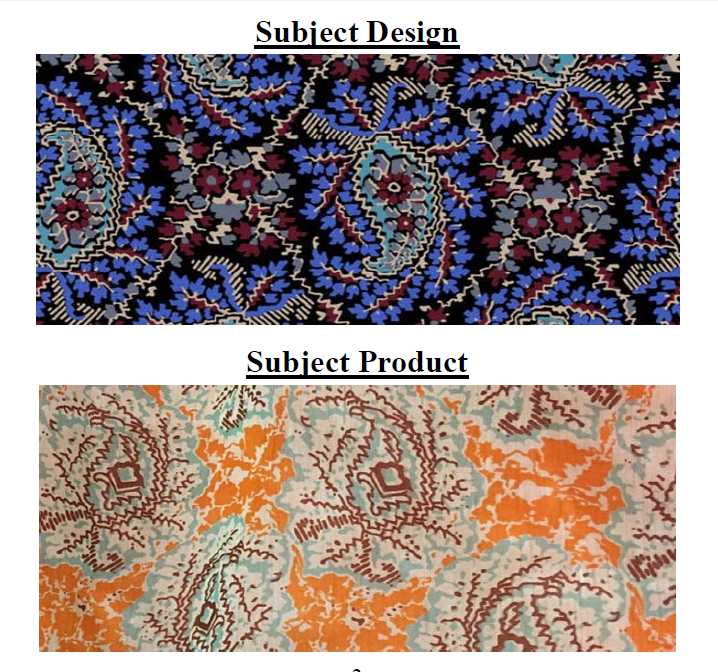Star Fabrics, Inc. is suing Cost Plus, a well-known retailer, for copyright infringement of artwork on fabric. Los Angeles based Star Fabrics owns a two-dimensional artwork print registered with the U.S. Copyright Office (Reg. No. VA 1-764-261). Star Fabrics alleges that Cost Plus had access to their two-dimensional fabric design due to Star Fabrics’ widespread dissemination of the fabric to numerous parties in the fashion and apparel industries. Star Fabrics alleges that Cost Plus and other defendants created garments with the same design protected by copyrights and sold them with a World Market label.
To prove copyright infringement, proof of ownership of the allegedly copied work as well as copying of the protected elements of the design covered by copyright are required. Narell v. Freeman, 872 F.2d 907, 910 (9th Cir. 1989). Star Fabrics’ certificate of copyright registration is prima facie evidence of validity and ownership. Next, because there is likely no direct evidence of copying, Star Fabrics must prove that the defendants had access to its design and that the two designs are substantially similar. Star Fabrics lists many ways in which the defendants may have had access to their design, including their showroom, illegally distributed copies of the design by vendors, or access to materials in the marketplace lawfully using the pattern.
When examining substantial similarity, a court reviews the similarity of the copyrightable aspects of a design in light of the accused design using a two-part test, first an extrinsic test and a second intrinsic test. Pasillas v. McDonald’s Corp., 927 F.2d 440 (9th Cir. 1991). “The extrinsic test requires plaintiffs to show overlap of concrete elements based on objective criteria.” Unicolors, Inc. v. Urban Outfitters, Inc., 853 F.3d 980, 985 (9th Cir. 2017). Courts may look at shapes, colors, arrangement, but also may examine the genre for common patterns and elements that may not be protectable. Experts usually provide opinions on the protectable elements of a design and similarity.
If on summary judgment the court, applying the objective extrinsic test, finds the designs to be dissimilar, the inquiry ends and the defendant prevails. If, however, the protectable elements are found to be similar, the court will then task the jury with the intrinsic test that subjectively examines the similarity of the expression of the idea. L.A. Printex Indus. v. Aeropostale, Inc., No. 10-56187, 2012 U.S. App. LEXIS 12033 (9th Cir. June 13, 2012). The intrinsic test focuses on whether the ordinary reasonable person would find “the total concept and feel of the works” to be substantially similar. Id. Dissimilarities can also be considered and used to make decisions of summary judgment when using the both the extrinsic and intrinsic tests. Pasillas, 927 F.2d 440, 443 (9th Cir. 1991).
Here, where the designs are not strikingly similar and not all elements can be found in both works, the court will focus on “whether a substantial portion of the protectable material in the plaintiff’s work was appropriated.” Worth v. Selchow & Righter Co., 827 F.2d 569, 580 n.1 (9th Cir. 1987). If a substantial portion or substantial elements were not copied, no copyright infringement can be found. Feist Publ’ns, Inc. v. Rural Tel. Serv. Co., 499 U.S. 340, 361 (1991)(“Not all copying, however, is copyright infringement.”).
Stars Fabrics requests that the court enjoin each of the defendants from importing, manufacturing, distributing, selling or any other trafficking of any products that infringe of their design. Under the Copyright Act, Star Fabrics also requests all profits from the sales of these designs, all losses suffered, and attorneys’ fees. 17 U.S.C. § 101 et. seq. Damages for copyright infringement can range up to $150,000. 17 U.S.C. § 504(c).
The case is Star Fabrics, Inc. v. Cost Plus, Inc. Case 2:18-cv-06245 (C.D. Cal. 2018).
 Los Angeles Intellectual Property Trademark Attorney Blog
Los Angeles Intellectual Property Trademark Attorney Blog


